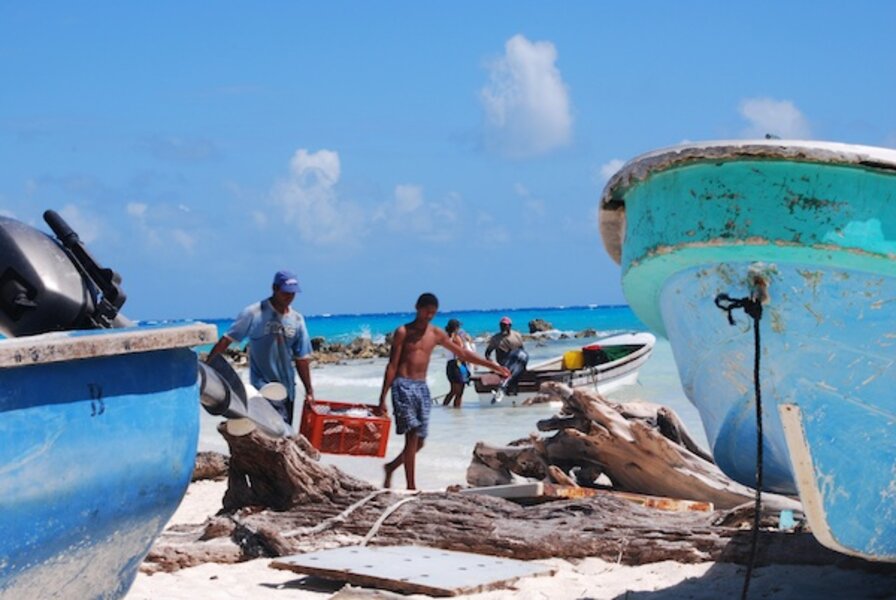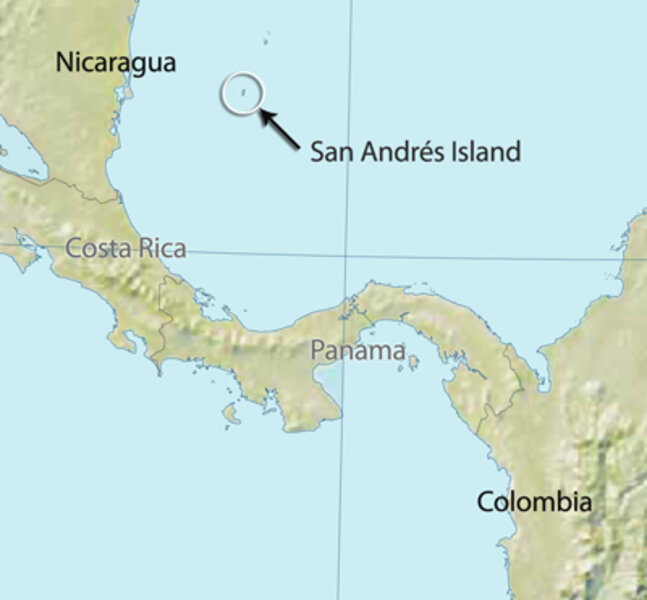Can Nicaragua protect the waters it won?
Loading...
| SAN ANDRÉS, Colombia
On a gusty afternoon, dozens of moored fishing boats rock in the surf as their captains play dominoes in the shade of palms.
The fishermen have been largely out of work since November, when the International Court of Justice (ICJ) in The Hague redrew the maritime border around this Colombian island in the Caribbean, extending Nicaragua’s exclusive economic zone north and south of San Andrés by about 30,000 square miles.
This means that fishing waters have been slashed for Colombian fisherman, says Denny Fox Biscaino, treasurer of the Artisanal Fisherman's Collective of San Andrés. But security experts in both countries agree that the ruling could have an unintended consequence: increasing drug trafficking in these blue-green seas.
“Nicaragua doesn’t have the resources, and we are going to see a surge in drug trafficking,” says John Marulanda, a Colombia-based defense consultant.
Nicaragua has one of the smallest and most antiquated naval fleets in Latin America, and it may have been granted more ocean than it can manage or police.
“There is a possibility that [fishermen will] mix with the narcos, or in the movement of guns,” now that some of the best fishing is beyond the reach of islanders, Mr. Biscaino says. “They possibly could if they don’t see any other way.”
'Limited' and 'outdated' fleet
The dispute leading to the ICJ’s decision dates back to 1928, when Nicaragua signed a treaty agreeing to Colombia’s claims over an archipelago that includes San Andrés. Nicaragua argued that the treaty was invalid because it had been signed during a period of United States military intervention. The court responded with a compromise, confirming Colombia’s claim to the archipelago but nearly doubling Nicaragua’s sea zone to extend well beyond the 82nd meridian, the historical limit of Colombian waters.
The ICJ’s ruling could be a boon for drug smugglers because Colombia’s large naval fleet will be replaced by Nicaragua’s, which the security publication Jane’s has called “limited” and “outdated,” with many assets that are not functioning.
The Nicaraguan Navy has three speedy patrol boats that can guard the shores but cannot patrol the deep sea, says Roberto Cajina, a security consultant in Nicaragua. Colombia, by contrast, can claim a fleet of frigates, submarines, and approximately 100 patrol boats.
To combat the traffickers, Nicaragua’s government will have to seek military assistance from other nations. But Mr. Cajina says that Nicaragua has few options.
“Nicaragua’s friends in ideology – Venezuela, Iran, and Russia – have not responded” to its requests for support, he says.
Nicaragua has invited Colombia to participate in joint patrols, but these haven’t happened, and Colombian President Juan Manuel Santos continues to oppose the ICJ’s ruling. Last week, Santos ordered the Colombian Navy to boost its presence on the maritime border to protect the San Andrés fishermen, while Nicaraguan President Daniel Ortega countered with an offer to create a special zone for them – but his plan was short on details.
Cajina says that Nicaragua’s best – and likely only – option is to ask for more assistance from the United States, which has given the Central American nation about $30 million in military and police aid since 2008, according to the website Just The Facts, which tracks spending in Latin America.
But the relationship has become strained recently as Nicaragua has accepted large sums of money from Venezuela. Yet, even without outside support, Nicaragua’s military does not bear total responsibility for stopping drug trafficking in the Caribbean, Cajina says. “From where do the boats leave? They leave from Venezuela and Colombia.”
'What can I do?'
Down the road from the headquarters of the Colombian Navy's special command on San Andrés, a young fisherman who calls himself Leonél displays three red snappers, two yellowtails, and a heavy-lipped black grouper for sale.
It’s a poor catch for four days’ fishing, Leonél says. Filleting a red snapper, he complains of being unable to go near the 82nd meridian, where fish are more abundant, and he is worried about supporting his younger brothers, sisters, and 3-year-old daughter. “If I can’t fish, what can I do? I never studied, I just started fishing,” he says.
Many of his fellow fishermen face the same problem.
“The narcos pay the fishermen to bring gasoline, food, whatever they want,” says one, who asks not to be identified discussing drug trafficking, for safety reasons. “And right now there is no money in fishing.”
A favored route
In the 1980s, the Caribbean was a favored route for Colombian cartels, which used desolate islands to fill boats and airplanes with cocaine destined for Florida.
Today, sea smuggling routes include stops along the coastline of Central America – a bridge on the trail between South America’s cocaine producers, Mexico’s traffickers, and the large US market of consumers. Of the 850 metric tons of cocaine headed to the United States, about 90 percent now passes through Central America, according to the Defense Department, and a third of that through the Caribbean, according to the State Department.
San Andrés and its surrounding islands, 400 miles from the Colombian mainland and only 140 miles from Nicaragua, have long served as a collection point for drugs, which are then distributed among go-fast boats that shuttle them to Central America, or in some cases all the way to Mexico and the United States, says naval Capt. Luís Hernán Espejo Segura, commander of the Colombian Navy’s special command in San Andrés.
Seizures of cocaine in the waters around San Andrés more than doubled from 7.3 metric tons in 2011 to 20.8 tons last year, says Mr. Espejo, who calls the archipelago “an extremely critical zone.”
'A reality'
Espejo says the smugglers’ go-fast boats have up to four outboard motors and are piloted by young islanders who “know the behavior of the sea during different seasons and don’t fear covering thousands of miles in difficult conditions.” The island’s fishermen have also at times moved drugs in their vessels, but more often act as surveillance or relay gasoline to the go-fast boats, he says.
Two former San Andrés fishermen, known locally as the Cassandra twins, started out shuttling gasoline but eventually came to own a fleet of drug smuggling boats. San Andrés was hit with a wave of crime and murders after the brothers partnered with a well-known Colombian crime syndicate, Los Rastrojos, in 2010, fighting a rival gang for control of the island’s trafficking routes, according to local media reports.
The brothers fled the island a year ago, and Espejo says trafficking-related violence has dramatically decreased in San Andrés since their departure. In January, the brothers were captured in Honduras and Panama, but the influence of crime syndicates in the archipelago, northern Colombia, and Central America “is a reality,” says Marulanda, the Colombian security analyst.
Both Colombia and Nicaragua need to recognize the threat they face from trafficking syndicates and gangs, Marulanda says.
“This should be the main focus of the security forces of the Latin American states.”








